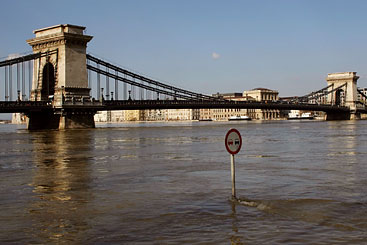
Preparing for floods – the new EU Flood Directive
In the last ten years, floods in Europe have caused 700 deaths, the displacement of half a million people, and €25 billion in insured economic losses. A new EU directive is helping to ensure better management of these risks.

Floods are natural phenomena, which have helped to shape natural landscapes, habitats and ecosystems in floodplains, wetlands and other lowlands. Floods can, however, turn into disasters causing widespread damage, health problems and casualties.
Catastrophic floods endanger lives and cause human tragedies as well as heavy economic losses. although floods are natural phenomena, society has become more vulnerable to natural hazards. More and more people are living and working in floodplains, reducing the capacity of flood plains to absorb flood waters. In addition, climate change is expected to lead to more intense rainfall and as a result flood risks are likely to increase in Europe in the coming years.
The EU Flood Directive, which was adopted on 18 September and entered into force on 26 November, aims to reduce and manage the risks that floods pose to human health, the environment, cultural heritage and economic activity. The Directive requires Member States to first carry out a preliminary assessment by 2011 to identify river basins and associated coastal areas at risk of flooding. For such areas, countries then need to draw up flood risk maps by 2013 and establish flood risk management plans focused on prevention, protection and preparedness by 2015.
The ICPDR on target. The EU Flood Directive fits in “very well” with the ICPDR’s Flood Action Programme, says Sandor Toth, Chairman of the ICPDR’s Flood Protection Expert Group. Both documents are based on the EU’s Best Practices Document on Flood Prevention, adopted in 2003. As a result, “both the EU Flood Directive and the Flood Action Programme share the same spirit and principles and the same approach”, says Toth.
The EU’s three-step approach is slightly different than the ICPDR’s Flood Action Programme, and preliminary flood risk assessments are required before the creation of flood hazards maps and flood risk maps. This extra step will be incorporated into the Flood Action Programme.
The Flood Protection Expert Group analysed the two documents and recommended amendments to the Flood Action Programme. These proposals include extending the scope of protection or management of risk to human health and economic activity, which are both part of the directive but are not explicitly mentioned in the Flood Action Programme. “We concentrated on human life and safety and the environment, and with property, rather than economic activity”, explains Toth.
Setting a longer timeline. The biggest difference between the two documents however is the schedule. The ICPDR set the deadline of final action plans at 2009. The preliminary assessments for the EU are set for 2011, flood mappings by 2013 and flood risk management plans are not required until 2015.
While the original ICPDR plan puts countries on a tight schedule, the Flood Directive could provide ample time to overcome obstacles. “Flood risk mapping will be a major road block”, says Toth, “as many countries will want to take advantage of EU funds for this costly task.” However, the evaluation of submitted project proposals will not be achieved earlier than November 2008 and the earliest such projects could begin would be 2009. Adopting the longer EU deadlines could ensure that countries have the vital tools they need to prevent, protect and prepare for floods.
Disclaimer
The information contained in the ICPDR website is intended to enhance public access to information about the ICPDR and the Danube River. The information is correct to the best of the knowledge of the ICPDR Secretariat. If errors are brought to our attention we will try to correct them.
The ICPDR, expert group members, nor other parties involved in preparation of information contained on this website cannot, however, be held responsible for the correctness and validity of the data and information provided, nor accept responsibility or liability for damages or losses arising directly or indirectly from the use of the information conveyed therein.
Only those documents clearly marked ICPDR documents reflect the position of the ICPDR.
Any links to other websites are provided for your convenience only. The ICPDR does not accept any responsibility for the accuracy, availability, or appropriateness to the user's purposes, of any information or services on any other website.
When using the information and material provided on this website, credit should be given to the ICPDR.
